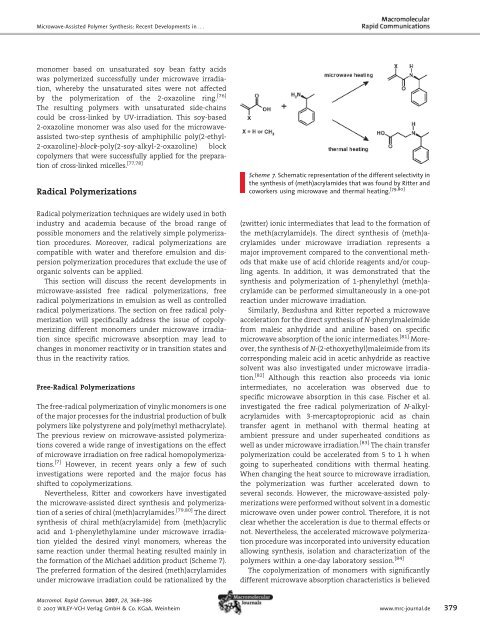Microwave-Assisted Polymer Synthesis: Recent Developments in a ...
Microwave-Assisted Polymer Synthesis: Recent Developments in a ...
Microwave-Assisted Polymer Synthesis: Recent Developments in a ...
You also want an ePaper? Increase the reach of your titles
YUMPU automatically turns print PDFs into web optimized ePapers that Google loves.
<strong>Microwave</strong>-<strong>Assisted</strong> <strong>Polymer</strong> <strong>Synthesis</strong>: <strong>Recent</strong> <strong>Developments</strong> <strong>in</strong> ...<br />
monomer based on unsaturated soy bean fatty acids<br />
was polymerized successfully under microwave irradiation,<br />
whereby the unsaturated sites were not affected<br />
by the polymerization of the 2-oxazol<strong>in</strong>e r<strong>in</strong>g. [76]<br />
The result<strong>in</strong>g polymers with unsaturated side-cha<strong>in</strong>s<br />
could be cross-l<strong>in</strong>ked by UV-irradiation. This soy-based<br />
2-oxazol<strong>in</strong>e monomer was also used for the microwaveassisted<br />
two-step synthesis of amphiphilic poly(2-ethyl-<br />
2-oxazol<strong>in</strong>e)-block-poly(2-soy-alkyl-2-oxazol<strong>in</strong>e) block<br />
copolymers that were successfully applied for the preparation<br />
of cross-l<strong>in</strong>ked micelles. [77,78]<br />
Radical <strong>Polymer</strong>izations<br />
Scheme 7. Schematic representation of the different selectivity <strong>in</strong><br />
the synthesis of (meth)acrylamides that was found by Ritter and<br />
coworkers us<strong>in</strong>g microwave and thermal heat<strong>in</strong>g. [79,80]<br />
Radical polymerization techniques are widely used <strong>in</strong> both<br />
<strong>in</strong>dustry and academia because of the broad range of<br />
possible monomers and the relatively simple polymerization<br />
procedures. Moreover, radical polymerizations are<br />
compatible with water and therefore emulsion and dispersion<br />
polymerization procedures that exclude the use of<br />
organic solvents can be applied.<br />
This section will discuss the recent developments <strong>in</strong><br />
microwave-assisted free radical polymerizations, free<br />
radical polymerizations <strong>in</strong> emulsion as well as controlled<br />
radical polymerizations. The section on free radical polymerization<br />
will specifically address the issue of copolymeriz<strong>in</strong>g<br />
different monomers under microwave irradiation<br />
s<strong>in</strong>ce specific microwave absorption may lead to<br />
changes <strong>in</strong> monomer reactivity or <strong>in</strong> transition states and<br />
thus <strong>in</strong> the reactivity ratios.<br />
Free-Radical <strong>Polymer</strong>izations<br />
The free-radical polymerization of v<strong>in</strong>ylic monomers is one<br />
of the major processes for the <strong>in</strong>dustrial production of bulk<br />
polymers like polystyrene and poly(methyl methacrylate).<br />
The previous review on microwave-assisted polymerizations<br />
covered a wide range of <strong>in</strong>vestigations on the effect<br />
of microwave irradiation on free radical homopolymerizations.<br />
[7] However, <strong>in</strong> recent years only a few of such<br />
<strong>in</strong>vestigations were reported and the major focus has<br />
shifted to copolymerizations.<br />
Nevertheless, Ritter and coworkers have <strong>in</strong>vestigated<br />
the microwave-assisted direct synthesis and polymerization<br />
of a series of chiral (meth)acrylamides. [79,80] The direct<br />
synthesis of chiral meth(acrylamide) from (meth)acrylic<br />
acid and 1-phenylethylam<strong>in</strong>e under microwave irradiation<br />
yielded the desired v<strong>in</strong>yl monomers, whereas the<br />
same reaction under thermal heat<strong>in</strong>g resulted ma<strong>in</strong>ly <strong>in</strong><br />
the formation of the Michael addition product (Scheme 7).<br />
The preferred formation of the desired (meth)acrylamides<br />
under microwave irradiation could be rationalized by the<br />
(zwitter) ionic <strong>in</strong>termediates that lead to the formation of<br />
the meth(acrylamide)s. The direct synthesis of (meth)acrylamides<br />
under microwave irradiation represents a<br />
major improvement compared to the conventional methods<br />
that make use of acid chloride reagents and/or coupl<strong>in</strong>g<br />
agents. In addition, it was demonstrated that the<br />
synthesis and polymerization of 1-phenylethyl (meth)acrylamide<br />
can be performed simultaneously <strong>in</strong> a one-pot<br />
reaction under microwave irradiation.<br />
Similarly, Bezdushna and Ritter reported a microwave<br />
acceleration for the direct synthesis of N-phenylmaleimide<br />
from maleic anhydride and anil<strong>in</strong>e based on specific<br />
microwave absorption of the ionic <strong>in</strong>termediates. [81] Moreover,<br />
the synthesis of N-(2-ethoxyethyl)maleimide from its<br />
correspond<strong>in</strong>g maleic acid <strong>in</strong> acetic anhydride as reactive<br />
solvent was also <strong>in</strong>vestigated under microwave irradiation.<br />
[82] Although this reaction also proceeds via ionic<br />
<strong>in</strong>termediates, no acceleration was observed due to<br />
specific microwave absorption <strong>in</strong> this case. Fischer et al.<br />
<strong>in</strong>vestigated the free radical polymerization of N-alkylacrylamides<br />
with 3-mercaptopropionic acid as cha<strong>in</strong><br />
transfer agent <strong>in</strong> methanol with thermal heat<strong>in</strong>g at<br />
ambient pressure and under superheated conditions as<br />
well as under microwave irradiation. [83] The cha<strong>in</strong> transfer<br />
polymerization could be accelerated from 5 to 1 h when<br />
go<strong>in</strong>g to superheated conditions with thermal heat<strong>in</strong>g.<br />
When chang<strong>in</strong>g the heat source to microwave irradiation,<br />
the polymerization was further accelerated down to<br />
several seconds. However, the microwave-assisted polymerizations<br />
were performed without solvent <strong>in</strong> a domestic<br />
microwave oven under power control. Therefore, it is not<br />
clear whether the acceleration is due to thermal effects or<br />
not. Nevertheless, the accelerated microwave polymerization<br />
procedure was <strong>in</strong>corporated <strong>in</strong>to university education<br />
allow<strong>in</strong>g synthesis, isolation and characterization of the<br />
polymers with<strong>in</strong> a one-day laboratory session. [84]<br />
The copolymerization of monomers with significantly<br />
different microwave absorption characteristics is believed<br />
Macromol. Rapid Commun. 2007, 28, 368–386<br />
ß 2007 WILEY-VCH Verlag GmbH & Co. KGaA, We<strong>in</strong>heim www.mrc-journal.de 379
















